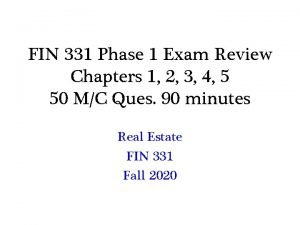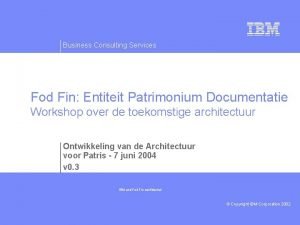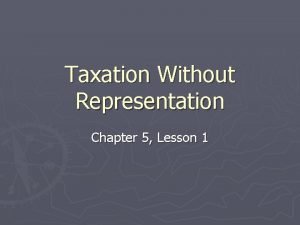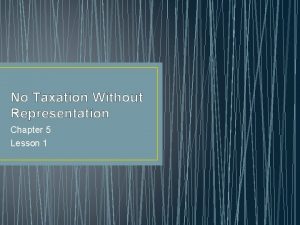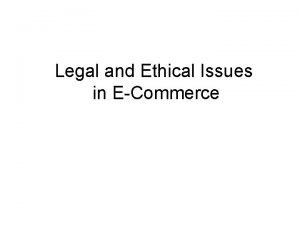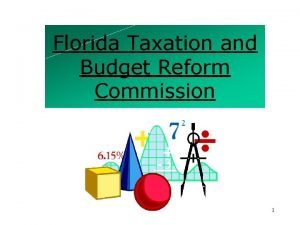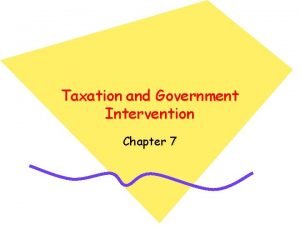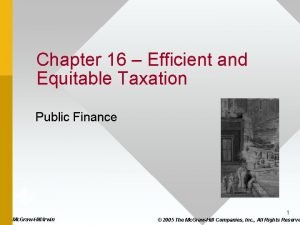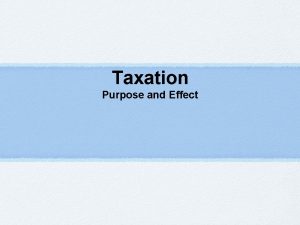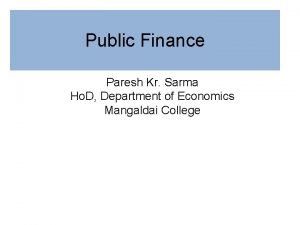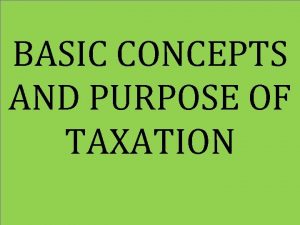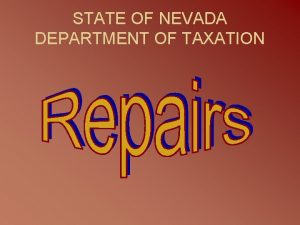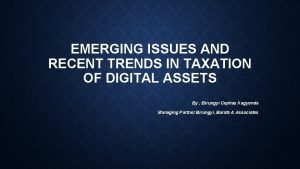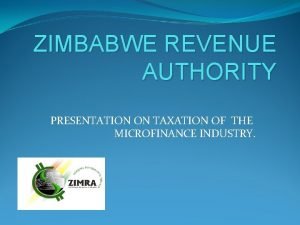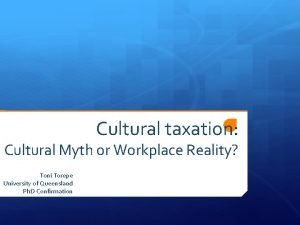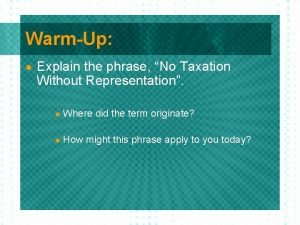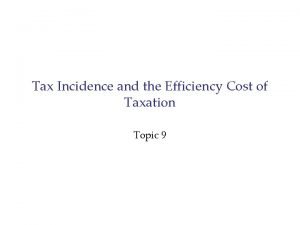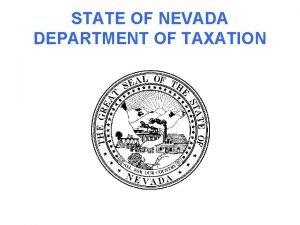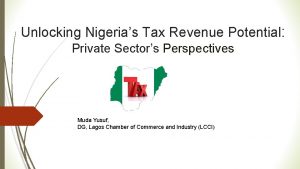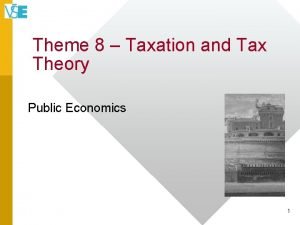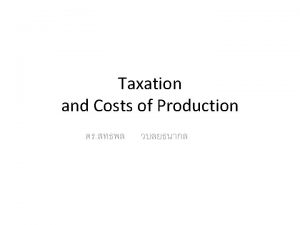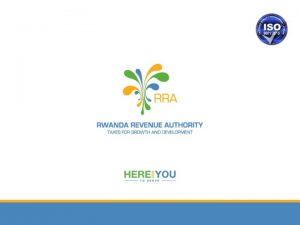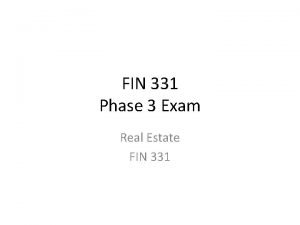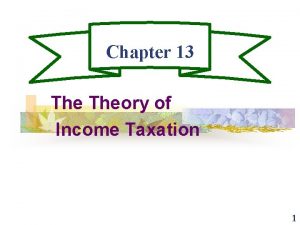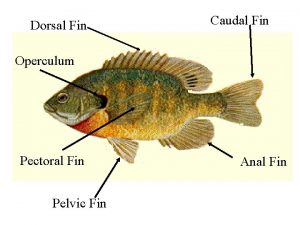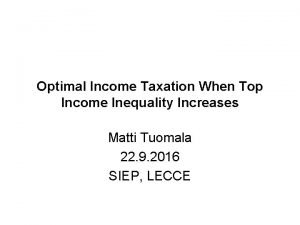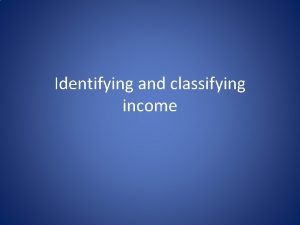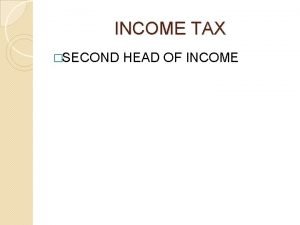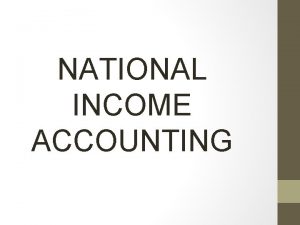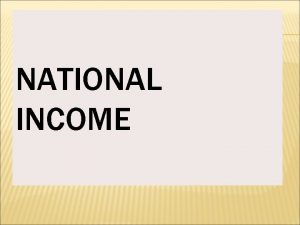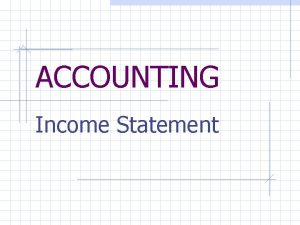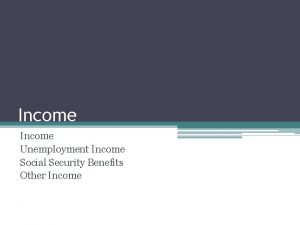Income Taxation and Value Chapter 20 FIN 331































- Slides: 31

Income Taxation and Value Chapter 20 FIN 331 REAL ESTATE David P Echevarria ALL RIGHTS RESERVED 1

OVERVIEW OF REAL ESTATE TAXATION Questions Examined A. B. C. D. E. F. What the objectives of tax law and taxation? How are different forms of ownership taxed? What are the classifications of Real Property? What specifications are in the IRS Tax Code? How do Taxes affect Valuation? What Special Topics affect Property Management? David P Echevarria ALL RIGHTS RESERVED 2

Tax Law objectives A. Raise Revenues for Federal and State Governments 1. Property Taxes 2. Capital Gains Taxes B. Promote socially desirable activities 1. Construction and rehabilitation of housing for low-income households 2. Rehabilitation of historic structures. C. IRS Key References 1. Rental Properties: IRS Publ. 527 2. Depreciation: IRS Publ. 946 David P Echevarria ALL RIGHTS RESERVED 3

Classes of Real Estate Property A. For purposes of federal income taxes real estate has four categories 1. Personal residences 2. Dealer property: property held for resale 3. Trade or Business property: Section 1231 4. Investment property: Topic 414, 415, Publ. 550 1) If not occupied, no gain/loss can be recognized in an exchange or held for investment David P Echevarria ALL RIGHTS RESERVED 4

Classes of Real Estate Property B. Depreciation and Federal Taxes 1. When permitted, depreciation allows investors to reduce their taxable income 2. Depreciation recognizes the economic wear and tear of commercial properties over time: included are dealer, trade or business, or investment properties 3. Personal residences cannot be depreciated for tax purposes 4. Trade or business real estate is tax in accordance with section 1231 of the federal tax code 5. Investment real estate is held primarily for capital appreciation, not rental income and as such cannot be depreciated for tax purposes David P Echevarria ALL RIGHTS RESERVED 5

Forms of Ownership and Taxation Issues B. General Partnerships 1. Pros a. Taxable income and losses flow directly the individual partners and avoids double taxation of income b. Each partner’s share of income, losses, and cash flow determined by the partnership agreement 2. Cons a. All general partners are liable for all debts of the partnership including contractual debts and debts due to legal actions against the partnership b. Due to unlimited liability of general partners, the personal assets of the partners are subject to claims with the partnership creditors David P Echevarria ALL RIGHTS RESERVED 6

Forms of Ownership and Taxation Issues C. Limited Partnerships 1. Pros a. A limited partnership introduces the trade-off by creating two distinct types of partners; the General partner and the Limited partner b. The Limited partner can limit their personal liability to an amount equal to their investment in the partnership 2. Cons a. Limited partnerships give up control of the partnership b. Limited partners are prohibited from participating in management and policymaking David P Echevarria ALL RIGHTS RESERVED 7

Forms of Ownership and Taxation Issues D. C-Corporations 1. Pros a. Corporations limit the liability of shareholders to the amount of their investment in the corporation’s stock 2. Cons a. Dividends paid to shareholders are not a deductible expense and are taxable as income to the shareholders b. The double taxation of dividends results in effective tax rates on income from properties held by corporations to run as high as 60%. State taxes can push this percentage even higher rendering corporate ownership less profitable David P Echevarria ALL RIGHTS RESERVED 8

Forms of Ownership and Taxation Issues E. S-Corporations 1. Pros a. S-corporations are a separate legal entity b. Provides for limited personal liability of shareholders 2. Cons a. S-corporations are not a separate taxable entity: Taxable income passes directly to the stockholder/owners b. Personal liability may arise if the corporate veil is waived in a court proceeding David P Echevarria ALL RIGHTS RESERVED 9

Forms of Ownership and Taxation Issues F. Limited Liability Companies (LLC) [See Publ. 3402, Form 8832 - Election] 1. Pros a. Limited liability for the investors (maybe) b. Offer better tax advantages to owners: can elect to be taxed as a sole proprietorship, partnership, C- or S-corporation; (avoid double taxation) 2. Cons a. Owners incur “pass-through” taxation; profits and losses reported to IRS on each owner’s Schedule K form. b. Pass-through income may be subject to state income taxes plus many states impose a franchise tax or “capital values tax”. David P Echevarria ALL RIGHTS RESERVED 10

Forms of Ownership and Taxation Issues G. Tenancy-in-Common (TIC) 1. Pro a. Provides for direct ownership of the property by the investors as opposed to indirect ownership in the previously described forms of business b. May avoid taxes on capital gains if they exchange for “like-kind” property: See section 1031 of the IRS code c. All have undivided interest. Death of one owner, share passes to estate. 2. Cons a. Syndication fees and other upfront expenses may consume up to 25% of initial equity c. Investors are subject to joint and several liability for the debts of the TIC; liability is not limited to the amount of their equity investment David P Echevarria ALL RIGHTS RESERVED 11

Alternative Forms of Ownership A. Direct Investment: 1. Purchasing individual properties in the private market 2. Investors own the properties directly B. Indirect investment 1. Pension funds: a portion of savings may be invested in real estate companies 2. Life insurance companies: a portion of premium payments invested in real estate 3. Real Estate Investment Trusts (REIT) David P Echevarria ALL RIGHTS RESERVED 12

Sources of Real Estate Financing A. Institutional and individual investors; hold 74% of all outstanding mortgage debt 1. Commercial banks: largest single source of private mortgage funds (54% in 2011) 2. Life insurance companies: provide approximate 13% 3. GSE’s provide approximately 11% 4. Savings institutions provide proximally 7% 5. The remaining 15% held by various Federal, State and local governments, Pension Funds, and other unclassified entities. David P Echevarria ALL RIGHTS RESERVED 13

Sources of Real Estate Financing B. Commercial Mortgage Backed Securities (CMBS) 1. CMBS backed by a pool of commercial mortgages 2. Offer premium yields over comparable government and corporate bonds 3. CMBS provides liquidity for mortgage originators by attracting nontraditional investors into the commercial real estate mortgage market David P Echevarria ALL RIGHTS RESERVED 14

Income Subject to Taxation A. Three types of income are subject to federal taxation 1. Active income: income earned from salaries, wages, commissions, and bonuses 2. Portfolio income: interest and dividend income on investments such as bonds and stocks 3. Passive income: all income generated from rental real estate investments regardless of whether or not the investors are managing the property or properties David P Echevarria ALL RIGHTS RESERVED 15

Income Subject to Taxation B. Significance of Passive Activity Loss (PAL) restrictions 1. Tax losses from passive activities can be used to offset positive taxable income from other passive activities 2. PAL’s cannot be used to offset active or portfolio income David P Echevarria ALL RIGHTS RESERVED 16

Estimating Tax Liabilities from Operations A. Eligible Deductions 1. 2. 3. 4. Operating expenses Above the line capital expenditures Depreciation Interest expense B. Taxable Income is the EGI minus Eligible Deductions 1. After-Tax Cash Flow (ATCF): a critical input to determine investment value via DCF 2. ATCF is different from net income in that it recognizes the impact of non-cash expenses David P Echevarria ALL RIGHTS RESERVED 17

Estimating Tax Liabilities from Operations C. Capital Improvements 1. Capital Expenditures above the line maintain the value the property and as such are tax deductible 2. Capital Expenditures below the line are meant to increase the value the property and as such are capitalized 3. Capitalized capital expenditures are added to the tax basis of the property and then expensed by annual depreciation charges David P Echevarria ALL RIGHTS RESERVED 18

Estimating Tax Liabilities from Operations D. Depreciable Basis 1. Original cost plus and the expenses incurred in acquiring the property such as brokerage and legal fees 2. The land component of the original cost basis is not depreciable 3. Additional complications: real property (the building structure) and personal property 4. Personal property includes such things as window air conditioners, refrigerators and microwave ovens, wall and floor coverings, swimming pools and tennis courts 5. Personal property is any tangible property not part of the building’s core structure David P Echevarria ALL RIGHTS RESERVED 19

Estimating Tax Liabilities from Operations E. Cost Recovery Periods (Depreciation) 1. Residential income producing property not < 27 ½ years 2. Nonresidential income producing property is 39 years 3. Personal property such as carpeting and draperies 3 years 4. Office equipment and fixtures 7 years 5. Landscaping and sidewalks 15 years 6. Three methods for depreciating property a. Straight-line b. 200% Declining Balance c. Modified ACRS (IRS) David P Echevarria ALL RIGHTS RESERVED 20

Estimating Tax Liabilities from Operations F. Tax Credits 1. Renovating or rehabilitating certain older or historic structures 2. Construction and rehabilitation of qualified low-income housing 3. Tax credits reduce the tax liability on a dollar for dollar basis David P Echevarria ALL RIGHTS RESERVED 21

Estimating Tax Liabilities from Sale A. Fully taxable sale treatment: when seller receives full payment in year of sale and taxable gains are fully recognized for tax purposes in the year sale B. Tax-deferred arrangements: when a portion of the sales proceeds and realized taxable gains are not fully recognized until a later year, if ever C. Adjusted basis: original cost basis plus any additional real property or personal property capital expenditures minus the cumulative amount of tax depreciation taken since the property was put in service David P Echevarria ALL RIGHTS RESERVED 22

Estimating Tax Liabilities from Sale D. Calculating Cash Flow from Sale 1. 2. 3. 4. 5. 6. 7. Selling price Minus selling expenses Equals net sale proceeds Minus remaining mortgage balance Equals before tax equity reversion Minus taxes due on sale Equals after-tax equity reversion David P Echevarria ALL RIGHTS RESERVED 23

Estimating Tax Liabilities from Sale E. Calculating the Adjusted Basis 1. 2. 3. 4. 5. 6. 7. Cost of land Plus cost of building to include personal property Plus acquisition expenses Equals original cost basis Plus additional capital expenditures Minus depreciation recapture Equals adjusted basis David P Echevarria ALL RIGHTS RESERVED 24

Estimating Tax Liabilities from Sale F. Calculating the Taxable Gain or Loss on Sale 1. Net sale proceeds 2. Minus adjusted basis 3. Equals total gain/loss David P Echevarria ALL RIGHTS RESERVED 25

Estimating Tax Liabilities from Sale G. Calculating Taxes Due on Sale 1. 2. 3. 4. 5. 6. 7. Net sale proceeds Minus adjusted basis Equals taxable gain Minus depreciation recapture Equals capital gain Plus depreciation recapture tax (maximum 25% rate) Equals taxes due on sale David P Echevarria ALL RIGHTS RESERVED 26

Like-Kind Exchanges A. A popular option for deferring capital gains taxes B. Section 1031 of the Internal Revenue Code allows owners of real estate, under certain circumstances, to exchange their properties for other properties to avoid paying some or all of the taxes that would ordinarily be paid in the year of the transaction David P Echevarria ALL RIGHTS RESERVED 27

Like-Kind Exchanges C. Requirements for Like-Kind exchanges 1. Properties must be trade or business properties or investment property such as land 2. The properties in an exchange must be like kind properties a. Real estate cannot be exchanged for personal property b. Apartment buildings can be exchanged for office buildings, office buildings are shopping centers, shopping centers for industrial warehouses and the like c. US property must be exchanged for US property d. Any cash or personal property received in the exchange is generally fully taxable in the year of the exchange ALL RIGHTS RESERVED David P Echevarria 28

Like-Kind Exchanges How do you report Section 1031 Like-Kind Exchanges to the IRS? You must report an exchange to the IRS on Form 8824, Like-Kind Exchanges and file it with your tax return for the year in which the exchange occurred. Form 8824 asks for: 1. 2. 3. 4. 5. 6. 7. Descriptions of the properties exchanged Dates that properties were identified and transferred Any relationship between the parties to the exchange Value of the like-kind and other property received Gain or loss on sale of other (non-like-kind) property given up Cash received or paid; liabilities relieved or assumed Adjusted basis of like-kind property given up; realized gain If you do not specifically follow the rules for like-kind exchanges, you may be held liable for taxes, penalties, and interest on your transactions. David P Echevarria ALL RIGHTS RESERVED 29

Like-Kind Exchanges Beware of Schemes Taxpayers should be wary of individuals promoting improper use of like-kind exchanges. Typically they are not tax professionals. Sales pitches may encourage taxpayers to exchange nonqualifying vacation or second homes. Many promoters of likekind exchanges refer to them as “tax-free” exchanges not “taxdeferred” exchanges. Taxpayers may also be advised to claim an exchange despite the fact that they have taken possession of cash proceeds from the sale. Consult a tax professional or refer to IRS publications listed below for additional assistance with IRC Section 1031 Like-Kind Exchanges. David P Echevarria ALL RIGHTS RESERVED 30

Homework Assignment A. Key Terms: 1. Active Income, Passive Income, Dealer Property, Depreciable Basis, Investment Property, Like-Kind Exchanges, Original Cost Basis, Section 1231 Property, Trade/Business Property B. Test Problems: 2, 5, 7, 8 C. Study Questions: 3, 4, 5 David P Echevarria ALL RIGHTS RESERVED 31
 Affirmative easement
Affirmative easement Spf fin fod fin
Spf fin fod fin Prisme droit à base trapèze
Prisme droit à base trapèze Chapter 5 lesson 1 no taxation without representation
Chapter 5 lesson 1 no taxation without representation Lesson 1 no taxation without representation
Lesson 1 no taxation without representation Contoh value creation adalah
Contoh value creation adalah Gdp per capita formula
Gdp per capita formula Journal entry for revaluation of assets
Journal entry for revaluation of assets Non operating income on income statement
Non operating income on income statement Calculate income tax
Calculate income tax Legal and ethical issues in ecommerce
Legal and ethical issues in ecommerce Taxation and budget reform commission
Taxation and budget reform commission Taxation and government intervention
Taxation and government intervention Efficient and equitable taxation
Efficient and equitable taxation Canons of taxation
Canons of taxation Effect of taxation
Effect of taxation Absolute taxable capacity
Absolute taxable capacity Classification of tax
Classification of tax Effect of taxation
Effect of taxation Adam smith canons of taxation
Adam smith canons of taxation Nevada department of taxation
Nevada department of taxation Business taxation syllabus
Business taxation syllabus Liberty equality brotherhood french revolution
Liberty equality brotherhood french revolution Daughters of liberty
Daughters of liberty Emerging issues in taxation
Emerging issues in taxation Zimra kurima house
Zimra kurima house Cultural taxation
Cultural taxation Explain the phrase no taxation without representation
Explain the phrase no taxation without representation How to find the tax revenue
How to find the tax revenue Nv modified business tax return
Nv modified business tax return Principles of taxation
Principles of taxation Tax principles
Tax principles
